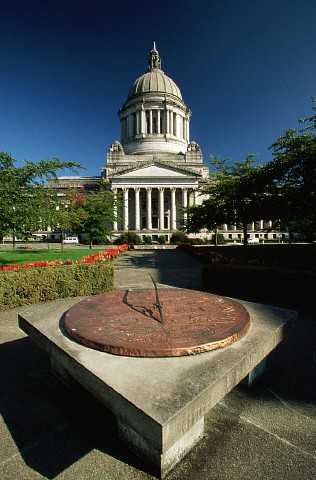What's New Under The Sun
Madison Historic Dial Returns
Monday, 13 October 2025 22:49
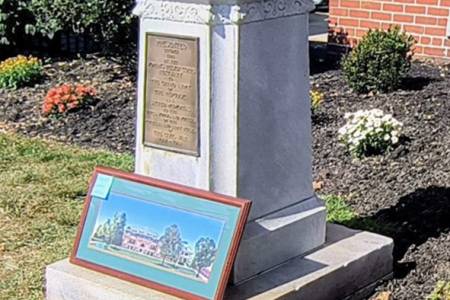 On October 4, 2025 Madison Historical Society of Ohio was able to have their sundial returned after 32 years, when in 1993 it was moved to the lawn of Lake County Courthouse to reduce the chance of vandalism. The sundial was originally placed at Madison Home 100 years ago on Saturday, October 24, 1925 during a conference of the Women's Relief Society. From 1904 to 1962 the state ran this...
On October 4, 2025 Madison Historical Society of Ohio was able to have their sundial returned after 32 years, when in 1993 it was moved to the lawn of Lake County Courthouse to reduce the chance of vandalism. The sundial was originally placed at Madison Home 100 years ago on Saturday, October 24, 1925 during a conference of the Women's Relief Society. From 1904 to 1962 the state ran this...
Elements of Dialing Course - 2025
Monday, 15 September 2025 19:42
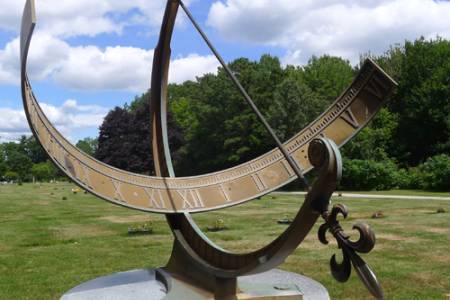 NASS is pleased to announce the upcoming fifth instance of Elements of Dialing, our introductory course about sundials, their history, and the science that makes them work. The free 12-lesson course, intended for those are new to sundialing, runs from 27 October 2025 until 26 April 2026. The course instructor is Robert Kellogg, NASS Vice President and Sundial Registrar. Bob will be...
NASS is pleased to announce the upcoming fifth instance of Elements of Dialing, our introductory course about sundials, their history, and the science that makes them work. The free 12-lesson course, intended for those are new to sundialing, runs from 27 October 2025 until 26 April 2026. The course instructor is Robert Kellogg, NASS Vice President and Sundial Registrar. Bob will be...
Sun Queen of World War II
Thursday, 11 September 2025 23:11
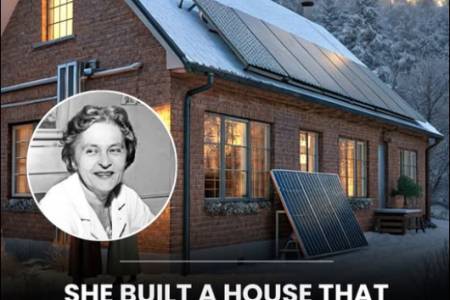 A Hungarian born American scientist, Mária Telkes (1900-1995), was called "The Sun Queen" and among other honors, was postmousthly inducted into the National Inventors Hall of Fame. She lived to 95 and for most of her life developed solar power in a variety of forms.
Trained as a biophysicist, she worked for Westinghouse Electrical and Manufacturing Company in Pittsburgh, PA, where she...
A Hungarian born American scientist, Mária Telkes (1900-1995), was called "The Sun Queen" and among other honors, was postmousthly inducted into the National Inventors Hall of Fame. She lived to 95 and for most of her life developed solar power in a variety of forms.
Trained as a biophysicist, she worked for Westinghouse Electrical and Manufacturing Company in Pittsburgh, PA, where she...
2025 Conference -Ottawa
Thursday, 28 August 2025 23:25
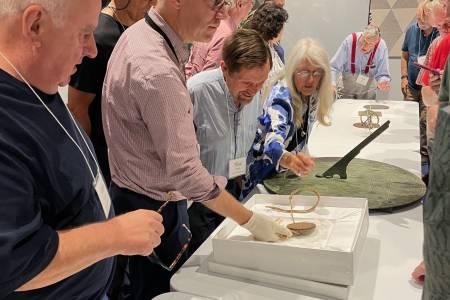 The annual NASS Conference was held 7-10 August, 2025 in Ottawa. As usual, the conference began late Thursday afternoon with an introduction social and a "grab bag give away", taking your chances with tickets to win the bag's prize. Will Grant was the final winner of the Walton Double Planar Polar Sundial, but Paul Ulbrich beat the statistic odds and won this prize three times,...
The annual NASS Conference was held 7-10 August, 2025 in Ottawa. As usual, the conference began late Thursday afternoon with an introduction social and a "grab bag give away", taking your chances with tickets to win the bag's prize. Will Grant was the final winner of the Walton Double Planar Polar Sundial, but Paul Ulbrich beat the statistic odds and won this prize three times,...
Prosciutto di Portici Sundial's Owner
Tuesday, 10 June 2025 18:51
 Prosciutto di Portici (Ham) Sundial
Photo: Getty Images
The Prosciutto di Portici Sundial, more often called the Portici Ham Sundial, dates from the first century somewhere between 8 BCE to 79 CE. This small silvered bronze dial was uncovered on 11 June, 1755 in the ruins of Herculaneum (current day Portici) in the "Villa of the Papyri", buried in...
Prosciutto di Portici (Ham) Sundial
Photo: Getty Images
The Prosciutto di Portici Sundial, more often called the Portici Ham Sundial, dates from the first century somewhere between 8 BCE to 79 CE. This small silvered bronze dial was uncovered on 11 June, 1755 in the ruins of Herculaneum (current day Portici) in the "Villa of the Papyri", buried in...
Hamilton Dial Dedicated
Friday, 06 June 2025 21:01
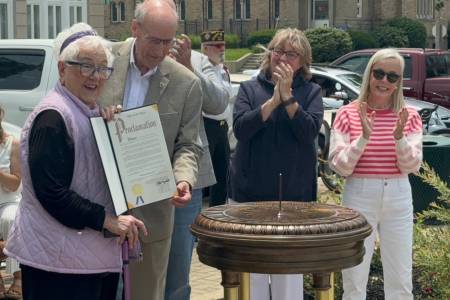 Sundial dedication May 31, 2025. At left is Kathleen Stuckey Fox, with the City Proclamation presented by Mayor Pat Moeller and City Council on-lookers Carla Fiehrer and Susan Vaughn offering congratulations.
On May 31, 2025 at 1pm, the Hamilton, Ohio, sundial (NASS Sundial Registry #1109) was re-dedicated in Monument Park. Originally dedicated in 1941 to the...
Sundial dedication May 31, 2025. At left is Kathleen Stuckey Fox, with the City Proclamation presented by Mayor Pat Moeller and City Council on-lookers Carla Fiehrer and Susan Vaughn offering congratulations.
On May 31, 2025 at 1pm, the Hamilton, Ohio, sundial (NASS Sundial Registry #1109) was re-dedicated in Monument Park. Originally dedicated in 1941 to the...
Frans Maes Received a Royal Decoration
Monday, 24 March 2025 21:33
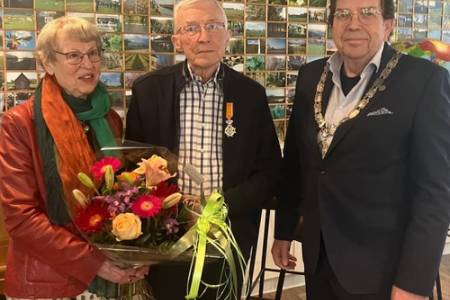 Several years ago Frans decided to write the course on sundials that included self assessment questions to force students not only to read the text, but to internalize the concepts. And a final submittal question "not necessarily a difficult question, but: no answer, no new lesson." Thus Frans Maes began writing lessons and sending them out to students.
NASS has now used his material to create...
Several years ago Frans decided to write the course on sundials that included self assessment questions to force students not only to read the text, but to internalize the concepts. And a final submittal question "not necessarily a difficult question, but: no answer, no new lesson." Thus Frans Maes began writing lessons and sending them out to students.
NASS has now used his material to create...
Pros and Cons of Daylight Savings Time
Monday, 24 March 2025 15:37
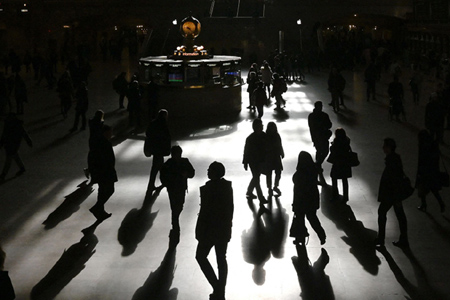 In a 24 March 2025 article from the on-line Science Advisor (American Association for the Advancement of Science) Phie Jacobs summarizes the "great debate" of the yearly shift from standard time to daylight savings time. In January 2025 the US Senate introduced the Sunshine Protection Act to permanently have daylight savings time year round. Certainly 54% of Americans do not like the...
In a 24 March 2025 article from the on-line Science Advisor (American Association for the Advancement of Science) Phie Jacobs summarizes the "great debate" of the yearly shift from standard time to daylight savings time. In January 2025 the US Senate introduced the Sunshine Protection Act to permanently have daylight savings time year round. Certainly 54% of Americans do not like the...
Native American Moon Alignment Ring
Friday, 21 March 2025 19:26
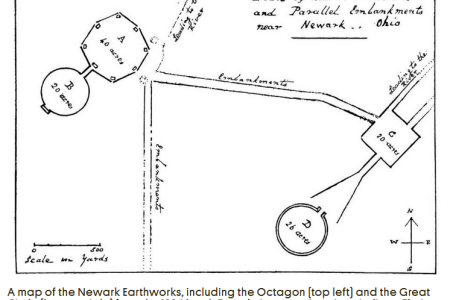 Perhaps the most famous alignment circle in the United States is the Cahokia Woodhenge near St. Louis constructed between 700-1400 CE by Cahokia Indigenous native Americans. But there were an estimated 10,000 other earthen mounds that once were scatter across the mid-west..
In an article from Atlas Obscura (https://www.atlasobscura.com/articles/octagon-earthworks-ohio) by Olivia Young on March...
Perhaps the most famous alignment circle in the United States is the Cahokia Woodhenge near St. Louis constructed between 700-1400 CE by Cahokia Indigenous native Americans. But there were an estimated 10,000 other earthen mounds that once were scatter across the mid-west..
In an article from Atlas Obscura (https://www.atlasobscura.com/articles/octagon-earthworks-ohio) by Olivia Young on March...
Hamilton Dial under Restoration
Friday, 21 March 2025 18:37
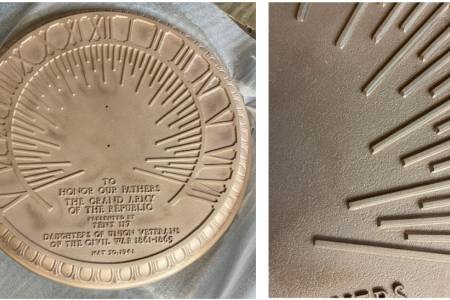 The Hamilton dial is in the restorative care of Jarrett and Celene Hawkins (Hawkins & Hawkins Custom, LLC in Cincinnati Ohio https://www.studio-hawkins.com/) in preparation for the dial's dedication on Saturday, May 31, 2025.
The face of the Hamilton Grand Army of the Republic (GAR) sundial has been cleaned and bead-blasted showing the dial as it was cast 84 years ago. In the process,...
The Hamilton dial is in the restorative care of Jarrett and Celene Hawkins (Hawkins & Hawkins Custom, LLC in Cincinnati Ohio https://www.studio-hawkins.com/) in preparation for the dial's dedication on Saturday, May 31, 2025.
The face of the Hamilton Grand Army of the Republic (GAR) sundial has been cleaned and bead-blasted showing the dial as it was cast 84 years ago. In the process,...
VSSC Space Museum gets Polar Sundial
Tuesday, 17 December 2024 23:47
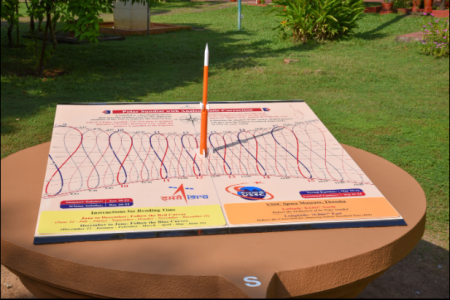 In November 2024, a team consisting of members from SPL, TTDG and CMD of VSSC successfully designed and installed an accurate and fully functional sundial at the Rocket Garden of VSSC Space Museum, Thumba (8.53°N, 76.86°E). Following a space theme, the vertical gnomon is a 3-stage rocket that casts its daily and seasonal shadow on a dial face 1 1/2 meters by 1 meter. The the sundial face...
In November 2024, a team consisting of members from SPL, TTDG and CMD of VSSC successfully designed and installed an accurate and fully functional sundial at the Rocket Garden of VSSC Space Museum, Thumba (8.53°N, 76.86°E). Following a space theme, the vertical gnomon is a 3-stage rocket that casts its daily and seasonal shadow on a dial face 1 1/2 meters by 1 meter. The the sundial face...
Historic Sundials of Andalusia
Saturday, 16 November 2024 00:07
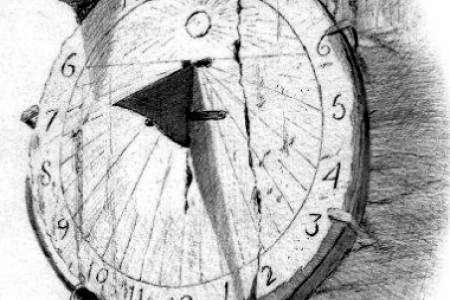 Esteban Martínez Almirón has published a new book Historical Sundials: Forgotten Andalusian Treasures (Relojes de Sol Históricos Tesoros Andaluces Olvidados) In it he reviews over 400 sundials from the Andalucian region of southern Spain Originally to celebrate the 25th year of the website https://relojandalusi.org/
Esteban Martínez Almirón began showing his sundial drawings on the site....
Esteban Martínez Almirón has published a new book Historical Sundials: Forgotten Andalusian Treasures (Relojes de Sol Históricos Tesoros Andaluces Olvidados) In it he reviews over 400 sundials from the Andalucian region of southern Spain Originally to celebrate the 25th year of the website https://relojandalusi.org/
Esteban Martínez Almirón began showing his sundial drawings on the site....
Hamilton Dial Dedicated
- Details
- Hits: 1789
|
Sundial dedication May 31, 2025. At left is Kathleen Stuckey Fox, with the City Proclamation presented by Mayor Pat Moeller and City Council on-lookers Carla Fiehrer and Susan Vaughn offering congratulations. |
On May 31, 2025 at 1pm, the Hamilton, Ohio, sundial (NASS Sundial Registry #1109) was re-dedicated in Monument Park. Originally dedicated in 1941 to the Grand Army of the Republic (GAR) near the shores of the Great Miami River by the Daughters of Union Veterans of the Civil War, the sundial faced 84 years of weathering, vandalism, and neglect, leaving it in a sad state.
Hamilton native and historian, Kathleen Stuckey Fox, stepped in to restore the dial and surrounding area of Monument Park, leading an engraved brick campaign to raise 10,000 dollars.The effort was supported by the citizens of Hamilton, Butler County Histrorical Society, the Hamilton Garden Club and the NASS who contributed 1500 dollars, which as Kathleen Stuckey Fox said, "to save one of their childrren."
Philanthropists James K. Fitton and the W.E. Smith Family Charitable Trust provided substantial support. At the end, 19,200 dollars were raised and 140 engraved bricks to surround the dial were purchased and donated. The sundial restoration and crafting of a new sundial gnomon was done under the care and expertise of Hawkins and Hawkings, LLC of Cincinnati (https://www.studio-hawkins.com/). They gave the bronze base and dial a warm brown patina with bight bronze pedestal legs. The dial stans proudly on an octagonal grey granite base engraved "May 31, 2025."
During the Sundial Dedication at Monument Park, Hamilton Mayor, Pat Moeller and City Coucil presented a Proclamation thanking Kathleen Stuckey Fox, urging “all citizens to recognize and show appreciation to Kathleen and the work she has accomplished to preserve the City of Hamilton’s history.” Mark Montgomery, representing the NASS, concluded his remarks with, “Many of the Grand Army of the Republic sundials across the country were established with great fanfare. No less today for the GAR sundial here in Hamilton. Enjoy this moment in time and may the sundial last another 100 years.”
Hamilton Dial under Restoration
- Details
- Hits: 2592
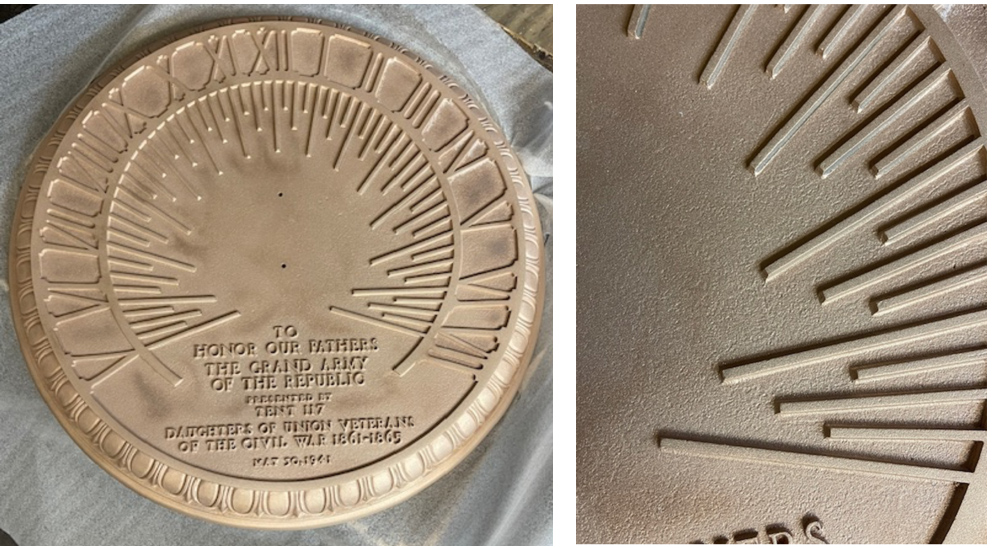 The Hamilton dial is in the restorative care of Jarrett and Celene Hawkins (Hawkins & Hawkins Custom, LLC in Cincinnati Ohio https://www.studio-hawkins.com/) in preparation for the dial's dedication on Saturday, May 31, 2025.
The Hamilton dial is in the restorative care of Jarrett and Celene Hawkins (Hawkins & Hawkins Custom, LLC in Cincinnati Ohio https://www.studio-hawkins.com/) in preparation for the dial's dedication on Saturday, May 31, 2025.
The face of the Hamilton Grand Army of the Republic (GAR) sundial has been cleaned and bead-blasted showing the dial as it was cast 84 years ago. In the process, Hawkins & Hawkins discovered a plate attached to the edge of the bottom half of the dial with the name "Newman Bros. Inc Cincinnati Ohio" The foundry most likely cast other GAR dials of similar design. Newman Brothers, Inc. began operation in 1882, providing cast iron and bronze hardware and continued into the 1950's creating "architectural and ornamental metal work in aluminum, bronze, nickel, silver and stainless steel" before closing their doors.
The restoraion is intended to leave the dial and four-post dial pedestal with minimum change to the original surfaces. What has worked well on other bronze dials is a light brown patina, leaving the top of the hour lines, marks, and lettering in a bright bronze finish.
A total of $19,200 for the dial's restoration was raised through donations and selling 140 engraved bricks that will be along a pathway leading to the dial. The path is being designed by Adam Cornette, Director of the Hamilton Parks Conservancy and his team. The engraved polished granite hexagon for the dial base is in Cincinnati, waiting to be delivered. The 140 engraved bricks are in safekeeping at a Hamilton storage facility. Everything has been arranged for the dedication on May 31, 2025, at 1:00pm at Monument Park in Hamilton. Mark Montgomery of the North American Sundial Society is slated to be one of the eight guest speakers. Following the dedication, a reception follows in the beautiful Soldiers, Sailors, and Pioneers Monument, dedicated on July 4, 1906.
Photos courtesy of Hawkins & Hawkins
Hamilton Dial Restoration
- Details
- Hits: 3159
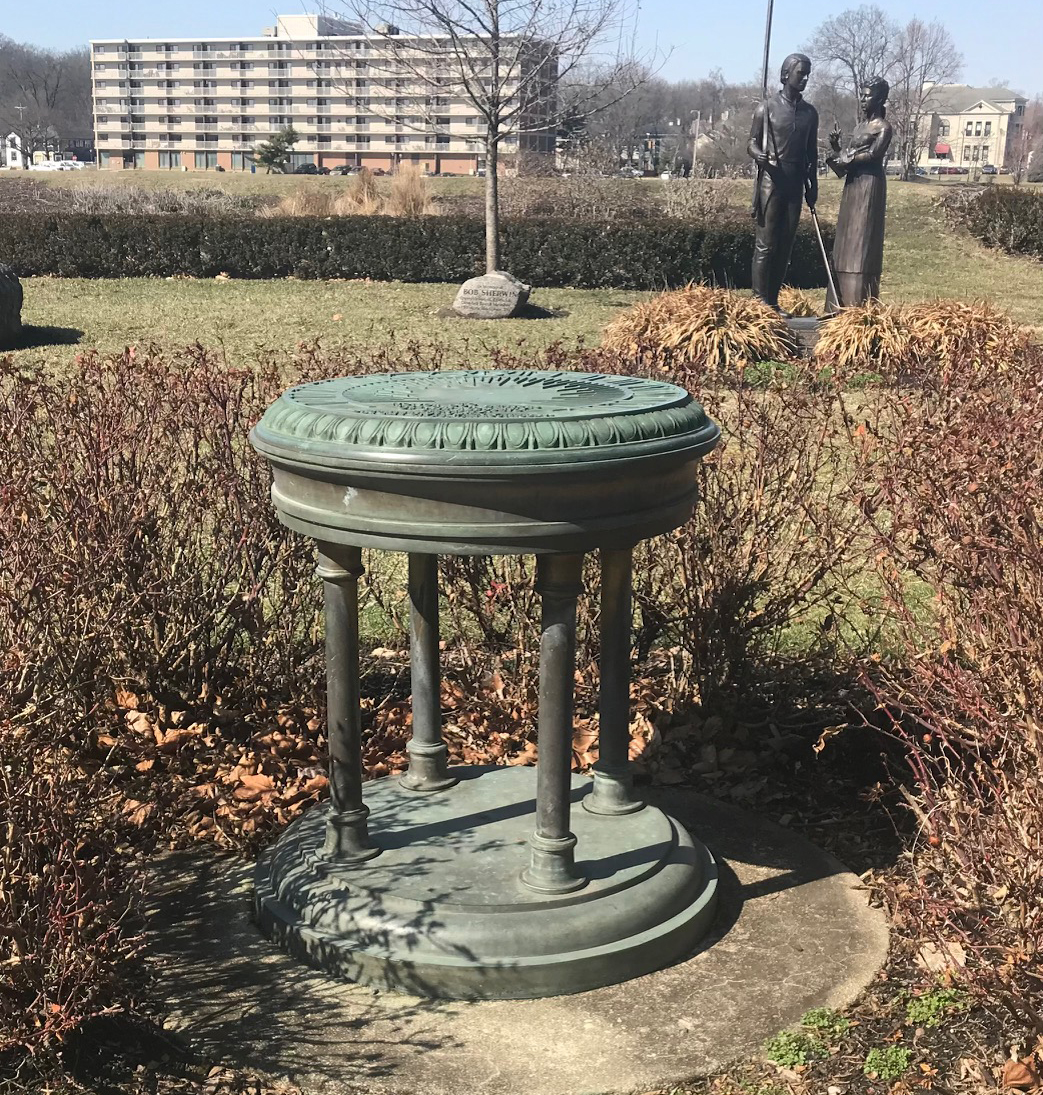 NASS Registered Sundial #1109 at https://sundials.org/index.php/sundial-registry/onedial/1109 is one of a series of bronze sundials presented by Daughters of Union Veterans of the Civil War, dedicated to the memory of the Grand Army of the Republic. Unfortunately the dial in Hamilton, Ohio, suffers from neglect and the gnomon has long been missing.
NASS Registered Sundial #1109 at https://sundials.org/index.php/sundial-registry/onedial/1109 is one of a series of bronze sundials presented by Daughters of Union Veterans of the Civil War, dedicated to the memory of the Grand Army of the Republic. Unfortunately the dial in Hamilton, Ohio, suffers from neglect and the gnomon has long been missing.
With support, this dial has been designated for restoration in 2025. A tri-fold brochure from the Butler County Historical Society is attached, explaining the restoration effort and asking for donations. Once restored it will be returned to Monument Park in Hamilton. NASS has contributed 1000 USD to the restoration effort and a local philanthropist has donated 5000 USD. Kathleen Fox, head of the restoration effort, reports that as of Nov 1, 2024, "Our total cash on hand now is a little over 15,000 USD and counting. We have two more months of the campaign left... and the goal of selling [memorial] bricks has just passed 100....We are also purchasing a polished granite hexagon piece on which to place the sundial. I have applied for a 2,500 USD grant to cover that cost."
Click on https://hamiltonthrive.com/c/restore-the-gar-sundial/ to read the history of this dial and to support the restoration effort through a 501(c)3. A short video is on this internet page explaining the restoration effort.
Louis B. Toomer and Sundial Remembered
- Details
- Hits: 12799
In June 2018 the Georgia Historical Society dedicated a historical marker in Chatham Square to Louis B. Toomer, which read in part "Louis Burke Toomer, African-American leader, local bank founder, and realtor, was born in Savannah in 1897. Raised and educated locally, Toomer established the Georgia Savings and Realty Corporation on February 23, 1927, in the historic black business district on West Broad Street. During segregation, the company provided banking, investment, and insurance services for blacks who were not always allowed access to white banking establishments...." [1]
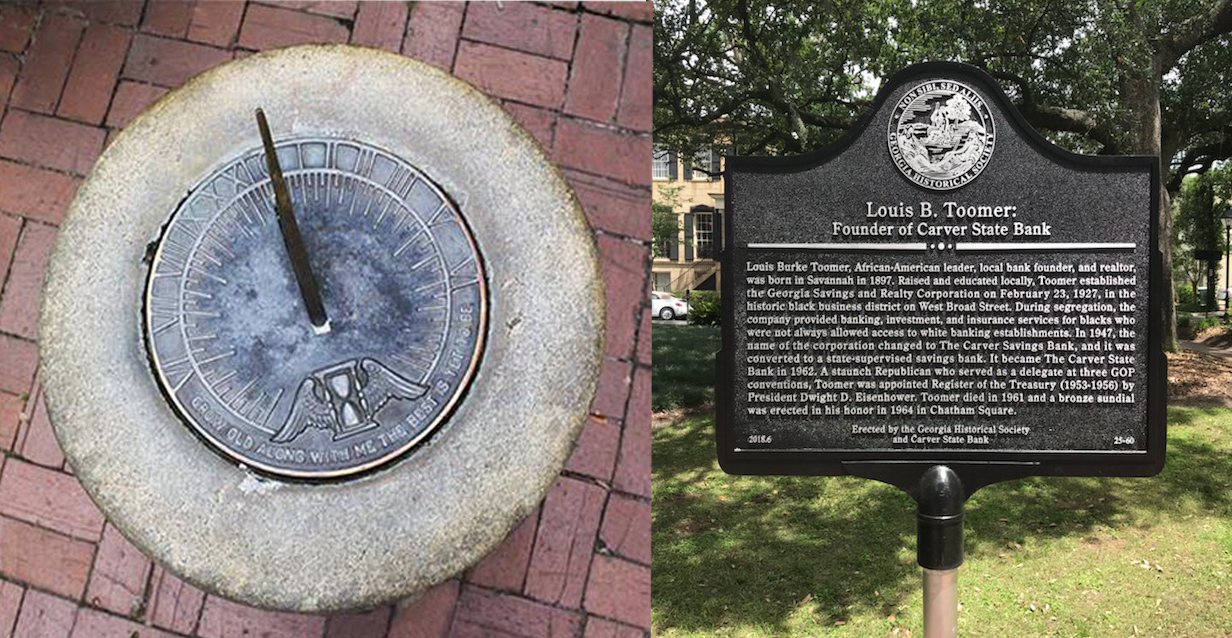
But before the historical marker was the Louis B. Toomer sundial in Chatham Square. As Georgia Wright Benton (past president of the Savannah Chapter of the National Conference of Artists) recalled:
"The sundial was dedicted in the spring of 1963 by the Savannah Chapter of the National Conference of Artists ... an organization comprised of black students throughout Chatham County along with their art teachers. West Broad Street School for black students was closed in 1962 and the pupils were transferred to Barnard Street School. Members of the National Conference of Artists visited the new school and one of our members observed that the park in front of the school, Chatham Square, needed improvement. Beautification of Chatham Square became a project for the organization, and the group decided to place a sundial in the square. We wanted something permanent that represented the black community in front of the Barnard Street school."
"The organization held several fundraisers to pay for the sundial. The primary fundraiser was a concert held in the Beach High School auditorium during the fall of 1962. Our concert artist was Kiah’s sister, a soprano singer. The fundraiser was a success and the sundial was purchased with help from Carver State Bank and Toomer’s wife, Janie. ... This sundial was the first dedication to an African-American in a Savannah square contributed by black students of a black organization." [2]
Over the years vandals have attacked and damaged the sundial. Each time, members of the Savannah-Chatham Historic Site and Monument Commission restored the sundial, " [making] a public plea for help and a reminder to the monument marauder that destruction of public property is a felony..." [3] You can see more of this dial in the NASS Sundial Registry (Georgia/Savannah #942).
[1] https://georgiahistory.com/events/historical-marker-dedication-louis-b-toomer-founder-of-carver-state-bank/
[2] https://www.savannahnow.com/opinion/20181129/letters-to-editor-friday-recalling-history-of-chatham-square-sundial
[3] https://www.savannahnow.com/news/2012-01-18/vandals-target-chatham-square-marker
Restored Cranmer Dial Dedicated
- Details
- Hits: 11578
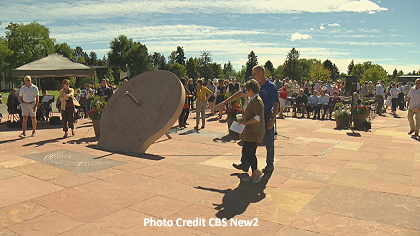 On Wed, Oct 3, 2018 the six-foot-tall Cranmer Sundial and surrounding Plaza were rededicated, celebrating the completion of a 2 million renovation project that started nearly two years ago. The city's Parks and Recreation Department replaced the cracked and sinking terrazzo plaza that was originally laid in the 1930s. They improved the drainage system that was a factor in the plaza's deteriation as well.
On Wed, Oct 3, 2018 the six-foot-tall Cranmer Sundial and surrounding Plaza were rededicated, celebrating the completion of a 2 million renovation project that started nearly two years ago. The city's Parks and Recreation Department replaced the cracked and sinking terrazzo plaza that was originally laid in the 1930s. They improved the drainage system that was a factor in the plaza's deteriation as well.
In 1941 George Cranmer placed a sundial of Chinese tradition on what was then called Mountain View Park. But in 1966 the original Cranmer Sundial was blown up with dynamite. The community rallied to raise funds and through the Erickson Monument Company, erected a large 6-foot disk equatorial dial of pink granitie on a terrazzo plaza. But the years did not treat the sundial well. When the sundial fell into disrepair the community pulled together again, and through the organization The Park People started "Save Our Sundial" and began fundraising. In all, citizens were able to raise $830,000 for the dial's repair. The Denver City Council committed to the rest of the funding, but the restoration would not be possible without the financial support of the residence of Hilltop community.
At the dedication, City Councilwoman of District 5, Mary Beth Susman said, “To have it restored to what George Cranmer’s vision was ... meaningful to all of us, and to have it restored in such a beautiful way, with the inlay still there, I can’t tell you how moving it is to celebrate this day.” [CBS News]
Read more:
https://www.thedenverchannel.com/news/our-colorado/-2-million-project-restores-historic-denver-sundial-at-cranmer-park
https://denver.cbslocal.com/2018/10/03/hilltop-cranmer-park-sundial/
Portland Vets to Restore High School Sundial
- Details
- Hits: 12693
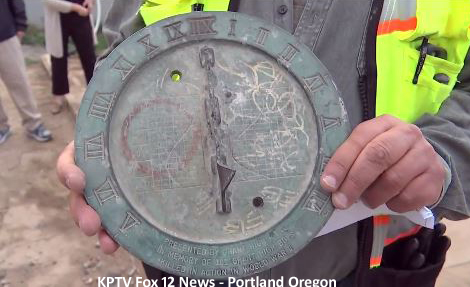 In Portland Oregon during the rennovation of Ulysses S. Grant High School an old brass sundial with only the remenant of a gnomon stood on a concrete pedestal ready to be turned into scrap metal and dust. But now according to Portand KPTV "a group of veterans want to bring it back similar to its original state." The dial, about 8 inches in diameter with Roman numerals from 5am to 7pm has the engraved inscription "Presented by Grant High School in Memory of the Grant High Boys Killed in Action in World War II"
In Portland Oregon during the rennovation of Ulysses S. Grant High School an old brass sundial with only the remenant of a gnomon stood on a concrete pedestal ready to be turned into scrap metal and dust. But now according to Portand KPTV "a group of veterans want to bring it back similar to its original state." The dial, about 8 inches in diameter with Roman numerals from 5am to 7pm has the engraved inscription "Presented by Grant High School in Memory of the Grant High Boys Killed in Action in World War II"
KPTV Fox News 12 reporter Tyler Dumont interviewed Daniel Thompson, "We're going to restore it and make it a part of the future of Grant High School," He and other contractors, all veterans, formed a group to restore it for the school's opening in the summer of 2019. Thompson continued, "As a veteran, all the veterans feel like remembering the wars that were fought and the wars we're still fighting - it's important that everybody, every student, does not forget that."
Tyler Dumont summed it up: "A historic piece of patriotism and honor at Northeast Portland’s Grant High School: this sundial is in memory of 101 former Grant students that were killed in World War II. After years of vandalism & aging, a group of veterans are set to restore it." pic.twitter.com/5NsibjDTfp
See KPTV's video of the sundial and interview at: https://www.kptv.com/news/group-restoring-historic-sundial-honoring-veterans-at-portland-high-school/article_9d2d432a-b52d-11e8-a26e-c3d447a6d595.html
Territorial Sundial Restored
- Details
- Hits: 26141
|
Territorial Sundial at Washington State Capitol Campus before Resotration |
John W. Elliot, a Seattle master craftsman designed and executed the Territorial Sundial, a 6-foot dial hand-hammered in brass with a bronze rod gnomon in 1959. (NASS SUndial Registtry #319). But the dial had tarnished with age and weather and the gnomon bent and broken.
As of January 4, 2018, the Territorial Sundial returns to the Washington State Capitol Campus. For the last six months the 59 year old dial went through considerable rennovation. A new gnomon has been crafted as a replica of the original, but with improved attachments. According to "From Our Corner", the Washinfgton Secretary of State Blog, "Repairs have also been made to the face of the sundial, as well as work on the sundial’s base and anchoring system to ensure its face is flat and horizontal...The sundial will now be sturdier than ever with improved durability while maintaining its original historic appearance. [The] Department of Enterprise Services consulted with the Department of Archaeology and Historic Preservation and the State Arts Commission in deciding to replicate the artwork."
Within the 6-foot dial face "There are eight panels that depict important milestones in our territorial history. The quote by Marcus Aurelius on its display reads, “Time is a sort of river of passing events, and strong is its current.” This beautiful dial, now restored as an accurate device more measuring solar time, will be dedicated at noon on Tuesday, January 30th, 2018.
Read more at: https://blogs.sos.wa.gov/FromOurCorner/index.php/2018/01/territorial-sundial-returns-to-capitol-campus/
|
Territorial Sundial Installation - January 2018 |
Cranmer Sundial Restoration to Begin
- Details
- Hits: 13834
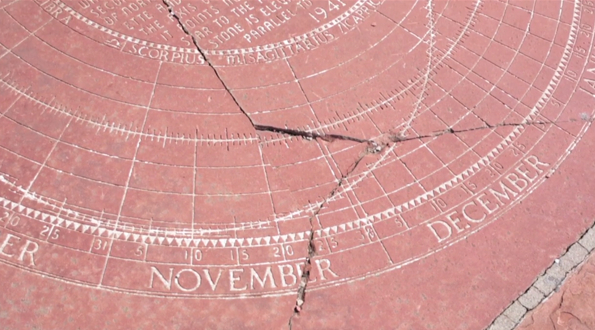 Damage to Erickson Equatorial Sundial in Cranmer Park, Denver, CO. Photo Credit: Save Our Sundial Damage to Erickson Equatorial Sundial in Cranmer Park, Denver, CO. Photo Credit: Save Our Sundial |
In 1941 George Cranmer undertook to place a sundial of Chinese tradition in Mountain View Park (now Cranmer Park) in the area of Hillside, Denver. Dan Babcock and Stephen Ionides of Erickson Monument Company translate the Chinese characters into Arabic. Unfortunately the dial was dynamited by vandals in 1966, and through the Erickson Monument Company, a large 6-foot disk equatorial dial of pink granitie was erected on a terrazzo plaza.
Climate and a sinking foundation led to the deteriation of the dial and plaza. In June 2014 the CIty of Denver committed 545,000 dollars to restore the Cranmer sundial and plaza through the Parks and Recreation and the Arts and Venues departments with the proviso that the citizens raise another million dollars.
A group local group of neighbors orgainized as The Park People started "Save Our Sundial" and began fundraising. By April 2017 they raised 680,000 dollars that will augment the city's set aside of 870,000 dollars for the project.
See: https://www.denverite.com/looks-like-cranmer-park-sundial-will-saved-33833/
The Denver Patch reports that a total of $2 million is available for the project. Denise Sanderson, "a local advocate and organizer for the park restoration" created the "Save Our Sundial" project which is run by The Park People with Executive Director Kim Yuan-Farrel. City coordinator is Lauri Dannemiller, Executive Director of Parks & Recreation City & County of Denver. The restoration would not be possible without the financial support and community activism of the residence of Hilltop community. Neighbors met Monday, Dec. 18 to celebrate the beginning of the reconstruction at Cranmer Park which will begin in early 2018 and completed by late fall 2018 if seasonal weather permits.
See: https://patch.com/colorado/denver/sundial-repair-denvers-cranmer-park-begin
1695 Malta Sundial Restored
- Details
- Hits: 10356
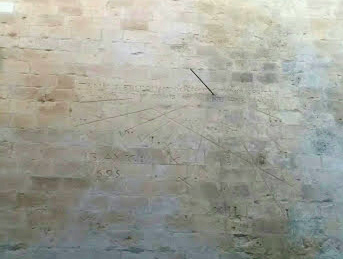 In January of this year we reported that the Malta 1695 vertical sundial on the wall of the Jesuits' Church, next to the Old University entrance on St. Paul Street in Valleta was in severe disrepair. Alexei Pace reports that "restoration of the 1695 sundial in Valletta, has now been completed. All the vegetation and fungal growth/mold has beeen removed and the stonework re-pointed."
In January of this year we reported that the Malta 1695 vertical sundial on the wall of the Jesuits' Church, next to the Old University entrance on St. Paul Street in Valleta was in severe disrepair. Alexei Pace reports that "restoration of the 1695 sundial in Valletta, has now been completed. All the vegetation and fungal growth/mold has beeen removed and the stonework re-pointed."


